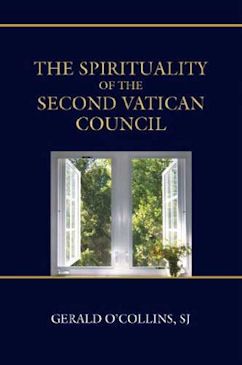
|
Posted August 9, 2014
Book: The Spirituality of the Second Vatican Council Author: Gerald O'Collins, SJ Paulist Press. Mahwah NJ. 2014. Pp. 80 An Excerpt from the Jacket:
Regrettably, the spirituality of the Second Vatican Council (1962-65) is rarely considered in the volumes of material written about it in the last fifty years. Vatican II famously emphasized the baptismal call to holiness, and its sixteen documents contain a wealth of guidance on how that is to be lived. Here Fr. O'Collins describes and develops what the Council knew this call to involve: cultivating a sense of the manifold presence of Christ; living with others in a priestly, prophetic, and pastoral way; being constantly fed and led by the Scriptures; and pursuing a Christ-centered existence that hears the cry of those who suffer and desperately need our help. From its opening document on the Church in the modern world, Gaudium et Spes, Vatican II is a rich and essential resource for Catholic spirituality. An Excerpt from the Book: Be In Dialogue The last chapter reported the attractive plea for dialogue with which the Council ended. "Be in dialogue within the Church and with all other human beings" comes across as a proper and even essential Christian characteristic. But putting this invitation into practice runs up against deeply self-referential patterns of speaking and acting exhibited by many or even most people. It is, of course, only too easy to notice and note the shortcomings of others. But the warnings against remaining "a self-referential Church" with which Pope Francis began his pontificate need to be seriously examined. To what extent am I and my Christian community self-referential or at least self-referential in ways that impede or even rule out genuine dialogue with others? The dialogue is essentially bilateral: that is to say, engaged with the perspective of others and ready to enter into their self-understanding. This means being transformed with them into a new communion, in which we become what we were not before. At the Second Vatican Council, the bishops, or at least the overwhelming majority of the bishops, heard the voice of the others, discovered valuable new things, and did not remain what they were before. The dialogue they practiced over four years --- a dialogue with one another, with the official "observers" from other Christian churches, and with many others --- formed part of their Christian witness to and proclamation of the good news. If they firmly endorsed dialogue in their closing document, they had shown themselves to be shining examples in the practice of such dialogue. As we saw, the first circle of dialogue embraced by Gaudium et Spes was dialogue within the Catholic Church. The need for such dialogue cannot be stressed too much. Unless and until such dialogue between Catholics really moves forward, will any authentic dialogue with "the others" take place? It is temptingly easy to settle down and ascribe to those with whom we disagree what the Germans call a Feinbild, or the face of an enemy to be avoided. Nowadays much of what Jesus said about loving one another could be translated as "be in genuine, humble, and honest dialogue with one another." Table of Contents: 1. The universal call to holiness 2. The presence of Jesus Christ 3. Being led and fed by the Word of Life 4. Being priests, prophets, and Kings/shepherds 5. The Council's vision of Jesus Christ 6. The Council's closing vision for the Church 7. Nine invitations |
|
